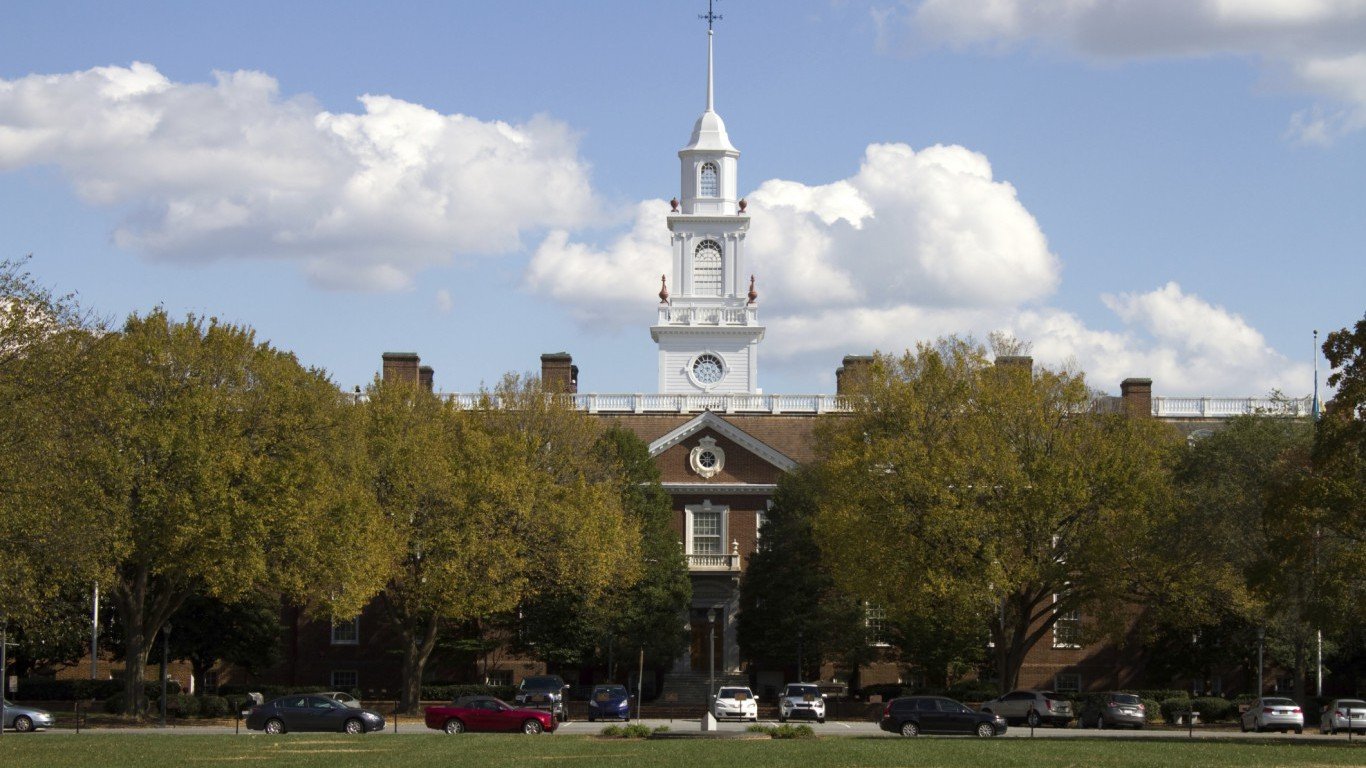Special Report
States Where Doctors Earn the Most (and Least)

Published:
Last Updated:

Medical doctors consistently rank among the highest compensated professions in the country. In every state, an average primary care physician earns at least $166,000 more than the average salary across all occupations. However, how much doctors earn varies greatly depending on location and specialty.
The average primary care physician’s annual salary ranges from roughly $205,000 in West Virginia to $330,000 in Alaska. In order to determine the states where doctors earn the highest and lowest salaries, 24/7 Wall St. reviewed 2014 and 2015 salary data provided by Doximity, an online social networking service for U.S. doctors.
While health insurance coverage and health care spending per capita varies widely across states, such factors do not appear to bear a strong relationship with doctors’ salaries. Rather, basic economic forces largely determine doctor salaries in each state.
Click here to see the states where doctors earn the most (and least).
In keeping with the laws of supply and demand, doctor salaries tend to be higher where there are fewer doctors. There are roughly 127 primary care physicians for every 100,000 Americans nationwide. In all but three of the 25 states where doctors earn the most, there are fewer primary care physicians per capita than there are nationwide. Conversely, there are more primary care physicians per capita than there are nationwide in a majority of the states on the lower end of the doctor pay scale.
In an interview with 24/7 Wall St., Joel Davis, a spokesperson for Doximity, explained that the physical location and desirability of a state as a place to live can also play a role in a physician’s pay. Pay needs to be higher in order to “get physicians to take a job in Alaska, for instance, as compared to getting somebody to take a job in … New York or California or [another] coastal state,” said Davis. Indeed, 19 of the states where primary care physicians earn the lowest salaries are coastal states, while the majority of states with doctors earning the highest average salaries have no oceanic or great lake coastline.
The presence of medical schools in a given state can increase the number of doctors, and consequently, affect the average doctor’s salary, Davis explained. “States with more medical schools tend to produce more doctors, and there’s a higher propensity for those doctors to stay in state.” To be sure, 18 of the 25 highest paying states for doctors are home to schools enrolling fewer medical students per capita than the national enrollment ratio. In West Virginia, the state with the lowest average pay for primary care physicians, there are 84 medical students for every 100,000 residents, the largest share in the country and more than double the corresponding national figure.
Along with geography, specialty also plays a considerable role in pay disparity among medical doctors. On average, specialists earn higher salaries than primary care physicians in every state. “Somebody who specializes has a greater degree of knowledge and skill … within a specific subdomain,” Davis said. Perhaps as a result, there are “fewer of them and they get paid more to do what they do.” Incomes still vary greatly among these higher paid positions. While the average pediatric endocrinologist earns roughly $185,000 annually, for example, neuro and thoracic surgeons each earn average salaries of well over half a million dollars.
In order to determine the states paying doctors the most and least, 24/7 Wall St. reviewed physician pay data from Doximity, an online social networking service for U.S. physicians. Doximity compiled doctor pay data from surveys of more than 35,000 doctors across the U.S. in 49 different specialties in 2014 and 2015. Average pay by state across all occupations came from the Bureau of Labor Statistics (BLS) for the most recent available year. We also considered medical school enrollment data by state from the Association of American Medical Colleges (AAMC). The number of primary care physicians per capita came from the Health Resources and Services Administration. Rates of insurance coverage were provided by County Health Rankings.
These are the states where doctors earn the most (and leas

50. West Virginia
> Avg. doctor salary: $204,750
> Avg. medical specialist salary: $373,000
> Avg. salary for all occupations: $37,880
> Primary care physicians (per 100,000 residents): 109.2 (18th lowest)
> Health care spending per capita: $7,667 (11th highest)
> Uninsured rate: 17.1% (18th highest)

49. Delaware
> Avg. doctor salary: $218,000
> Avg. medical specialist salary: $393,000
> Avg. salary for all occupations: $49,520
> Primary care physicians (per 100,000 residents): 114.3 (21st lowest)
> Health care spending per capita: $8,480 (5th highest)
> Uninsured rate: 10.9% (7th lowest)

48. Michigan
> Avg. doctor salary: $228,750
> Avg. medical specialist salary: $341,000
> Avg. salary for all occupations: $45,140
> Primary care physicians (per 100,000 residents): 124.1 (21st highest)
> Health care spending per capita: $6,618 (19th lowest)
> Uninsured rate: 12.9% (15th lowest)

47. Maryland
> Avg. doctor salary: $233,000
> Avg. medical specialist salary: $322,000
> Avg. salary for all occupations: $53,470
> Primary care physicians (per 100,000 residents): 183.7 (2nd highest)
> Health care spending per capita: $7,492 (14th highest)
> Uninsured rate: 11.7% (10th lowest)

46. Maine
> Avg. doctor salary: $235,500
> Avg. medical specialist salary: $375,000
> Avg. salary for all occupations: $42,140
> Primary care physicians (per 100,000 residents): 135.2 (12th highest)
> Health care spending per capita: $8,521 (4th highest)
> Uninsured rate: 13.5% (18th lowest)

45. Massachusetts
> Avg. doctor salary: $238,000
> Avg. medical specialist salary: $329,000
> Avg. salary for all occupations: $57,610
> Primary care physicians (per 100,000 residents): 206.7 (the highest)
> Health care spending per capita: $9,278 (the highest)
> Uninsured rate: 4.3% (the lowest)

44. New Mexico
> Avg. doctor salary: $239,250
> Avg. medical specialist salary: $348,000
> Avg. salary for all occupations: $42,230
> Primary care physicians (per 100,000 residents): 119.9 (25th lowest)
> Health care spending per capita: $6,651 (21st lowest)
> Uninsured rate: 21.9% (4th highest)

43. Rhode Island
> Avg. doctor salary: $240,750
> Avg. medical specialist salary: $291,000
> Avg. salary for all occupations: $49,570
> Primary care physicians (per 100,000 residents): 179.6 (4th highest)
> Health care spending per capita: $8,309 (7th highest)
> Uninsured rate: 13.8% (19th lowest)

42. New York
> Avg. doctor salary: $241,750
> Avg. medical specialist salary: $352,000
> Avg. salary for all occupations: $55,630
> Primary care physicians (per 100,000 residents): 170.1 (5th highest)
> Health care spending per capita: $8,341 (6th highest)
> Uninsured rate: 12.4% (12th lowest)

41. Ohio
> Avg. doctor salary: $242,000
> Avg. medical specialist salary: $360,000
> Avg. salary for all occupations: $43,900
> Primary care physicians (per 100,000 residents): 129.7 (15th highest)
> Health care spending per capita: $7,076 (18th highest)
> Uninsured rate: 13.0% (17th lowest)

40. Virginia
> Avg. doctor salary: $242,750
> Avg. medical specialist salary: $355,000
> Avg. salary for all occupations: $50,750
> Primary care physicians (per 100,000 residents): 127.2 (17th highest)
> Health care spending per capita: $6,286 (11th lowest)
> Uninsured rate: 14.0% (20th lowest)

39. Georgia
> Avg. doctor salary: $243,250
> Avg. medical specialist salary: $370,000
> Avg. salary for all occupations: $44,670
> Primary care physicians (per 100,000 residents): 107.1 (15th lowest)
> Health care spending per capita: $5,467 (3rd lowest)
> Uninsured rate: 21.1% (5th highest)

38. New Hampshire
> Avg. doctor salary: $243,500
> Avg. medical specialist salary: $371,000
> Avg. salary for all occupations: $47,060
> Primary care physicians (per 100,000 residents): 137.5 (11th highest)
> Health care spending per capita: $7,839 (8th highest)
> Uninsured rate: 12.8% (13th lowest)

37. Oregon
> Avg. doctor salary: $243,750
> Avg. medical specialist salary: $354,000
> Avg. salary for all occupations: $46,850
> Primary care physicians (per 100,000 residents): 134.6 (14th highest)
> Health care spending per capita: $6,580 (17th lowest)
> Uninsured rate: 17.2% (17th highest)

36. Pennsylvania
> Avg. doctor salary: $244,000
> Avg. medical specialist salary: $352,000
> Avg. salary for all occupations: $45,750
> Primary care physicians (per 100,000 residents): 135.1 (13th highest)
> Health care spending per capita: $7,730 (10th highest)
> Uninsured rate: 11.6% (9th lowest)

35. Idaho
> Avg. doctor salary: $246,000
> Avg. medical specialist salary: $429,000
> Avg. salary for all occupations: $39,770
> Primary care physicians (per 100,000 residents): 81.5 (the lowest)
> Health care spending per capita: $5,658 (4th lowest)
> Uninsured rate: 18.8% (14th highest)

34. Colorado
> Avg. doctor salary: $246,500
> Avg. medical specialist salary: $346,000
> Avg. salary for all occupations: $49,860
> Primary care physicians (per 100,000 residents): 123.2 (23rd highest)
> Health care spending per capita: $5,994 (7th lowest)
> Uninsured rate: 16.0% (22nd highest)

33. Vermont
> Avg. doctor salary: $247,250
> Avg. medical specialist salary: $299,000
> Avg. salary for all occupations: $44,540
> Primary care physicians (per 100,000 residents): 181.3 (3rd highest)
> Health care spending per capita: $7,635 (12th highest)
> Uninsured rate: 8.7% (3rd lowest)

32. North Carolina
> Avg. doctor salary: $247,750
> Avg. medical specialist salary: $342,000
> Avg. salary for all occupations: $43,280
> Primary care physicians (per 100,000 residents): 119.7 (24th lowest)
> Health care spending per capita: $6,444 (14th lowest)
> Uninsured rate: 18.1% (16th highest)

31. Alabama
> Avg. doctor salary: $248,500
> Avg. medical specialist salary: $382,000
> Avg. salary for all occupations: $40,890
> Primary care physicians (per 100,000 residents): 103.5 (11th lowest)
> Health care spending per capita: $6,272 (10th lowest)
> Uninsured rate: 15.9% (24th highest)

30. Illinois
> Avg. doctor salary: $248,500
> Avg. medical specialist salary: $378,000
> Avg. salary for all occupations: $48,780
> Primary care physicians (per 100,000 residents): 138.8 (10th highest)
> Health care spending per capita: $6,756 (23rd lowest)
> Uninsured rate: 14.6% (22nd lowest)

29. Hawaii
> Avg. doctor salary: $251,750
> Avg. medical specialist salary: $332,000
> Avg. salary for all occupations: $46,230
> Primary care physicians (per 100,000 residents): 140.9 (9th highest)
> Health care spending per capita: $6,856 (24th highest)
> Uninsured rate: 7.6% (2nd lowest)

28. South Carolina
> Avg. doctor salary: $252,500
> Avg. medical specialist salary: $366,000
> Avg. salary for all occupations: $39,570
> Primary care physicians (per 100,000 residents): 108.8 (17th lowest)
> Health care spending per capita: $6,323 (12th lowest)
> Uninsured rate: 18.6% (15th highest)

27. New Jersey
> Avg. doctor salary: $252,750
> Avg. medical specialist salary: $383,000
> Avg. salary for all occupations: $53,920
> Primary care physicians (per 100,000 residents): 145.2 (8th highest)
> Health care spending per capita: $7,583 (13th highest)
> Uninsured rate: 15.0% (23rd lowest)

26. Kansas
> Avg. doctor salary: $256,250
> Avg. medical specialist salary: $412,000
> Avg. salary for all occupations: $42,020
> Primary care physicians (per 100,000 residents): 108.3 (16th lowest)
> Health care spending per capita: $6,782 (25th lowest)
> Uninsured rate: 14.1% (21st lowest)

25. Mississippi
> Avg. doctor salary: $258,250
> Avg. medical specialist salary: $373,000
> Avg. salary for all occupations: $36,750
> Primary care physicians (per 100,000 residents): 84.7 (2nd lowest)
> Health care spending per capita: $6,571 (16th lowest)
> Uninsured rate: 20.0% (9th highest)

24. Missouri
> Avg. doctor salary: $259,250
> Avg. medical specialist salary: $396,000
> Avg. salary for all occupations: $42,790
> Primary care physicians (per 100,000 residents): 115.2 (23rd lowest)
> Health care spending per capita: $6,967 (22nd highest)
> Uninsured rate: 15.3% (24th lowest)

23. Florida
> Avg. doctor salary: $259,500
> Avg. medical specialist salary: $378,000
> Avg. salary for all occupations: $41,820
> Primary care physicians (per 100,000 residents): 111.7 (19th lowest)
> Health care spending per capita: $7,156 (17th highest)
> Uninsured rate: 24.3% (2nd highest)

22. Oklahoma
> Avg. doctor salary: $259,750
> Avg. medical specialist salary: $371,000
> Avg. salary for all occupations: $40,850
> Primary care physicians (per 100,000 residents): 85.2 (3rd lowest)
> Health care spending per capita: $6,532 (15th lowest)
> Uninsured rate: 20.6% (7th highest)

21. Texas
> Avg. doctor salary: $261,000
> Avg. medical specialist salary: $373,000
> Avg. salary for all occupations: $45,330
> Primary care physicians (per 100,000 residents): 99.4 (8th lowest)
> Health care spending per capita: $5,924 (6th lowest)
> Uninsured rate: 24.8% (the highest)

20. Arizona
> Avg. doctor salary: $261,250
> Avg. medical specialist salary: $387,000
> Avg. salary for all occupations: $44,580
> Primary care physicians (per 100,000 residents): 99.7 (9th lowest)
> Health care spending per capita: $5,434 (2nd lowest)
> Uninsured rate: 20.0% (10th highest)

19. Montana
> Avg. doctor salary: $262,000
> Avg. medical specialist salary: $407,000
> Avg. salary for all occupations: $39,880
> Primary care physicians (per 100,000 residents): 102.6 (10th lowest)
> Health care spending per capita: $6,640 (20th lowest)
> Uninsured rate: 20.0% (8th highest)

18. California
> Avg. doctor salary: $262,250
> Avg. medical specialist salary: $352,000
> Avg. salary for all occupations: $53,890
> Primary care physicians (per 100,000 residents): 123.3 (22nd highest)
> Health care spending per capita: $6,238 (9th lowest)
> Uninsured rate: 19.4% (11th highest)

17. Connecticut
> Avg. doctor salary: $263,250
> Avg. medical specialist salary: $374,000
> Avg. salary for all occupations: $55,060
> Primary care physicians (per 100,000 residents): 169.0 (6th highest)
> Health care spending per capita: $8,654 (3rd highest)
> Uninsured rate: 10.9% (8th lowest)

16. Arkansas
> Avg. doctor salary: $266,250
> Avg. medical specialist salary: $412,000
> Avg. salary for all occupations: $37,940
> Primary care physicians (per 100,000 residents): 105.3 (12th lowest)
> Health care spending per capita: $6,167 (8th lowest)
> Uninsured rate: 18.8% (13th highest)

15. Washington
> Avg. doctor salary: $267,000
> Avg. medical specialist salary: $378,000
> Avg. salary for all occupations: $52,540
> Primary care physicians (per 100,000 residents): 128.2 (16th highest)
> Health care spending per capita: $6,782 (25th lowest)
> Uninsured rate: 15.9% (23rd highest)

14. Tennessee
> Avg. doctor salary: $270,250
> Avg. medical specialist salary: $366,000
> Avg. salary for all occupations: $40,650
> Primary care physicians (per 100,000 residents): 126.4 (18th highest)
> Health care spending per capita: $6,411 (13th lowest)
> Uninsured rate: 16.2% (20th highest)

13. Kentucky
> Avg. doctor salary: $271,750
> Avg. medical specialist salary: $393,000
> Avg. salary for all occupations: $40,040
> Primary care physicians (per 100,000 residents): 107.0 (14th lowest)
> Health care spending per capita: $6,596 (18th lowest)
> Uninsured rate: 16.8% (19th highest)

12. Wyoming
> Avg. doctor salary: $274,250
> Avg. medical specialist salary: $433,000
> Avg. salary for all occupations: $44,930
> Primary care physicians (per 100,000 residents): 88.7 (5th lowest)
> Health care spending per capita: $7,040 (21st highest)
> Uninsured rate: 15.8% (25th highest)

11. Wisconsin
> Avg. doctor salary: $275,250
> Avg. medical specialist salary: $412,000
> Avg. salary for all occupations: $42,880
> Primary care physicians (per 100,000 residents): 125.3 (19th highest)
> Health care spending per capita: $7,233 (16th highest)
> Uninsured rate: 10.6% (6th lowest)

10. Louisiana
> Avg. doctor salary: $276,000
> Avg. medical specialist salary: $367,000
> Avg. salary for all occupations: $40,190
> Primary care physicians (per 100,000 residents): 125.0 (20th highest)
> Health care spending per capita: $6,795 (25th highest)
> Uninsured rate: 19.1% (12th highest)

9. Indiana
> Avg. doctor salary: $277,500
> Avg. medical specialist salary: $408,000
> Avg. salary for all occupations: $41,470
> Primary care physicians (per 100,000 residents): 106.7 (13th lowest)
> Health care spending per capita: $6,666 (22nd lowest)
> Uninsured rate: 16.1% (21st highest)

8. North Dakota
> Avg. doctor salary: $278,000
> Avg. medical specialist salary: $472,000
> Avg. salary for all occupations: $44,100
> Primary care physicians (per 100,000 residents): 122.4 (25th highest)
> Health care spending per capita: $7,749 (9th highest)
> Uninsured rate: 12.3% (11th lowest)

7. Minnesota
> Avg. doctor salary: $282,500
> Avg. medical specialist salary: $412,000
> Avg. salary for all occupations: $48,310
> Primary care physicians (per 100,000 residents): 146.2 (7th highest)
> Health care spending per capita: $7,409 (15th highest)
> Uninsured rate: 9.5% (4th lowest)

6. Utah
> Avg. doctor salary: $283,250
> Avg. medical specialist salary: $385,000
> Avg. salary for all occupations: $43,550
> Primary care physicians (per 100,000 residents): 90.5 (7th lowest)
> Health care spending per capita: $5,031 (the lowest)
> Uninsured rate: 15.3% (25th lowest)

5. Nevada
> Avg. doctor salary: $283,750
> Avg. medical specialist salary: $360,000
> Avg. salary for all occupations: $42,310
> Primary care physicians (per 100,000 residents): 85.6 (4th lowest)
> Health care spending per capita: $5,735 (5th lowest)
> Uninsured rate: 23.2% (3rd highest)

4. Nebraska
> Avg. doctor salary: $295,000
> Avg. medical specialist salary: $407,000
> Avg. salary for all occupations: $41,080
> Primary care physicians (per 100,000 residents): 123.1 (24th highest)
> Health care spending per capita: $7,048 (20th highest)
> Uninsured rate: 12.9% (16th lowest)

3. Iowa
> Avg. doctor salary: $304,750
> Avg. medical specialist salary: $378,000
> Avg. salary for all occupations: $41,120
> Primary care physicians (per 100,000 residents): 89.0 (6th lowest)
> Health care spending per capita: $6,921 (23rd highest)
> Uninsured rate: 9.6% (5th lowest)

2. South Dakota
> Avg. doctor salary: $305,250
> Avg. medical specialist salary: $411,000
> Avg. salary for all occupations: $37,300
> Primary care physicians (per 100,000 residents): 114.9 (22nd lowest)
> Health care spending per capita: $7,056 (19th highest)
> Uninsured rate: 12.8% (14th lowest)

1. Alaska
> Avg. doctor salary: $330,000
> Avg. medical specialist salary: $376,000
> Avg. salary for all occupations: $54,040
> Primary care physicians (per 100,000 residents): 114.2 (20th lowest)
> Health care spending per capita: $9,128 (2nd highest)
> Uninsured rate: 20.8% (6th highest)
Ever wanted an extra set of eyes on an investment you’re considering? Now you can speak with up to 3 financial experts in your area for FREE. By simply
clicking here you can begin to match with financial professionals who can help guide you through the financial decisions you’re making. And the best part? The first conversation with them is free.
Click here to match with up to 3 financial pros who would be excited to help you make financial decisions.
Thank you for reading! Have some feedback for us?
Contact the 24/7 Wall St. editorial team.